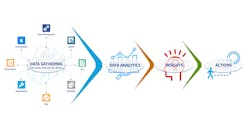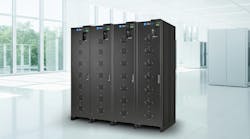The Future of Data Centers: An End-to-End Operating System Built on Clean Data
The need for clean data is nothing new for the industry, it just has not been available. Data centers are inherently complex to manage and operate. So many elements and assets are interrelated and interdependent and every interaction, from installation to routine maintenance, creates risk. This risk is exacerbated by the inability to collect clean operating data, provide full-stack visibility, and enhance BI and Generative AI.
The State of the Industry
The data center industry is at the core of all our world, housing all our IT and storage assets, critical applications, and the world’s data repository. Yet, we have not advanced much beyond the archaic processes, methods, and procedures of decades past. This has been largely due to outdated, disjointed, and siloed data collection systems, each with their own methods of classification and structure. This has led to manual, error prone, time consuming processes that ultimately produce questionable data that has hindered informed decision making at the executive level.
The reliance on antiquated data collection methods, a lack of connected systems, as well as a lack of asset performance data, has perpetuated the situation to where we are relatively blind in determining our risk tolerances. The most conservative approach possible to reliability is then taken, a complete risk avoidance measure. With the industry continuing to expand at such an aggressive growth rate, the lack of meaningful data to back decision making is not a sustainable situation.
Managing assets and operations across global data center portfolios with spreadsheets, voluminous amounts of procedures as well as the snowflake methods must come to an end. Furthermore, with regulatory pressures increasing globally, such as the EU’s Corporate Sustainability Reporting Directive (CSRD), the transition to a centralized operations system becomes imperative.
The implementation of a central, end-to-end operating system should be a critical part of data center deployments going forward, being treated at the same level of importance as the facility layout, design, construction, fiber providers and power distribution.
The Data Center Operating System
To meet the challenges before us, we need industry leading management systems and a software landscape across the data center. Each data center operator must have a shared foundation so all functionalities can be integrated, obtained, and visible through a single integrated source of truth. The need to digitize everything is imperative, moving us towards predictive maintenance and full-stack visibility into critical assets. Having a central operating system will truly move the industry to a predictive data center end state.
Optimizing by Digitizing
The data center operating system must be intuitive enough to drive simplicity in data collection and reporting.
It must provide a comprehensive solution for technicians, supervisors, and executives, allowing them to optimize operational processes and data collection and to facilitate real-time decision-making capabilities in the boardroom.
Data quality is a huge challenge. According to a report in Harvard Business Review, just 3% of the data in a business enterprise meets quality standards. Not only that, but joint research by Carnegie Mellon University and IBM found that 90% of data collected by businesses is “dark data,” collected but never successfully used for any strategic purpose, not used in any way to derive insights or for decision making. For data centers we need to flip "dark data" to 10% and clean data to 90%.
The crucial factors in a high performing data center portfolio is having access to clean, curated, and connected data. These factors help executives gain greater insights into their operations, and make truly data-driven capital planning and strategic asset management decisions, ensuring minimized risks, unswerving services, and uninterrupted uptime.
Predictive Data Center
The industry must embrace the development of an industry asset performance benchmarking system.
It is critical to have global visibility into asset reliability performance as we move more and more towards the future of the predictive data center. Not only should the data be centered on reliability, but also on sustainability as we move to reporting embodied carbon and energy use footprint. This need will be even more important with the explosion of AI and its true impacts on the data center. Today, we are in the crystal ball stage on AI’s global impact on our industry. We need to step up to the challenge before us.
The Bottom Line
Studies routinely show that companies with higher levels of digital maturity perform better than their peers. Across all categories - revenue, net profits, return on invested capital (ROIC), and growth - companies with higher levels of digital maturity are leading their industries thanks to improved efficiency, quality, and ability to adapt quickly to market changes.
As the data center industry evolves, the need for clean, curated, and connected data has never been more critical. By focusing on a centralized system that standardizes operational data, the industry can meet the challenge ahead, providing reliable, efficient, and sustainable infrastructure for the digital world. Data center executives who embrace an end-to-end data center operating system, implement predictive analytics, and use industry standards on data collection and asset naming conventions to ensure clean classification and accurate benchmarking data will excel in decision making compared to those relying on inconsequential data. Standardization is the key in providing critical insights through real-world industry operating data to ensure system reliability, operating efficiency, carbon reduction and enabling critical business decision making to ensure a sustainable future.
Brian Kortendick is Director, Strategy & Growth, MCIM by Fulcrum Collaborations. Contact MCIM to learn more about their data center solutions.



